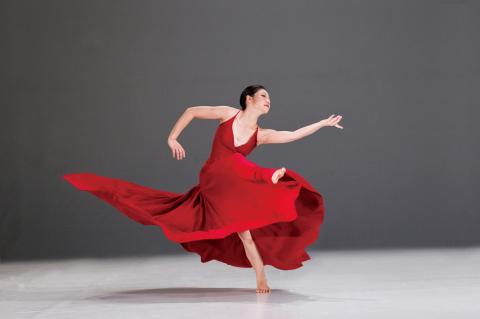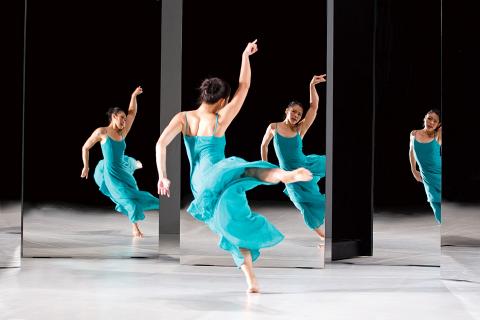Lin Hwai-min (林懷民) may self-deprecatingly say that he is getting too old, too tired, and too whatever to keep choreographing, but he still has a lot of surprises up his sleeves. And sometimes the surprise isn’t just for Cloud Gate Dance Theatre (雲門舞集) fans, but himself and his company.
To those for whom pieces like Moon Water (水月) or the Cursive (行草) trilogy symbolize Lin’s recent work for Cloud Gate, his latest production, How Can I Live On Without You (如果沒有你), will be an eye-opener. It is a love song to Taiwanese music of the past six decades, and a love song to his dancers and fans.
“Songs are a collective memory,” Lin said at a press conference back in September, shortly before the troupe departed for a multi-week tour of the US and a stint in London.

Photo courtesy of Liu Chen-hsiang
“Songs tell a history, you can tell an era from a song,” he said. “People will say: ‘Oh, I really loved that song,’ but people argue over the meaning.”
He also wanted to show audiences that Cloud Gate is not the same company as it was before, that it has a lot of younger faces.
Lin said he got the idea of using “modern” love songs while humming a line from the song How Can I Live On Without You (made famous by the late singer Bai Guang, 白光), in the shower and realizing how danceable it was. There was just one problem. Lin didn’t really know many popular songs; he had grown up listening to classical music. So he asked his dancers to each submit a list of favorite songs.

Photo courtesy of Liu Chen-hsiang
“Some I hadn’t heard before,” Lin said, adding that the late Lo Man-fei (羅曼菲) — one of the troupe’s original members and director of Cloud Gate 2 (雲門2) — was always trying to drag him to concerts by Wu Bai (伍佰) or other singers.
According to associate artistic director Lee Ching- chun (李靜君), her boss hadn’t heard most of the songs the dancers suggested.
“Mr Lin is always curious about what he doesn’t know,” Lee said in a telephone interview on Wednesday, adding that Lin was fascinated by “the journey of discovery, asking ‘Who’s that singer? Who’s that?’”
“He’s discovered a lot about the pop world, especially the words. As a writer, he’s very sensitive about words, so he was very interested the lyrics,” Lee said.
Since most of the songs were new to Lin, he didn’t play favorites when it came to selecting the 18 that would be in the show. The only considerations, he said, were the power of a song’s melody and whether it was danceable.
The songs certainly are an eclectic mix, ranging from Wu Bai, folk singer Tsai Chin (蔡琴), indie singer-songwriter Crowd Lu (盧廣仲), Fong Fei-fei (鳳飛飛) and Jay Chou (周杰倫) all the way back to 1940s crooner Bai Guang.
“Some of the dancers were disappointed that the songs they chose weren’t in the repertoire, but some were too nice to dance to, or sometimes just were not right,” Lee said, adding that Lin was still tweaking the playlist a month ago.
To link such disparate tunes together, Lin envisioned a kind of cabaret, with the dancers portraying a concert singer, a karaoke outing or a TV variety show.
It’s not just the music that’s so unusual for Cloud Gate. Lin’s style of working changed as well, Lee said, adding that it was very different from the way he choreographed the Cursive series.
“I’ve been here [with the company] for 28 years and this is the first time the studio was always full of laughter. It was the first time we saw Mr Lin swing his hips — because you know, he has to show the dancers what he wants, he doesn’t just tell them,” Lee said with a laugh. “Everyone who was in the studio feels the change.”
The creative mood was very different, less serious, with more interaction between Lee and the dancers and more give and take, she said.
“I keep telling the young dancers they don’t know how lucky they are that he is spending so much time with them. For some it’s their first solo, it’s so precious, this time with him,” she said. “He wants to get things right for them. It is a very special way [that] Mr Lin creates, finding what is right for each dancer.”
The costumes for the new production are also a departure. It’s not the first time the women have worn dresses of different colors — they did in Whisper of Flowers (花語) three years ago — but the vibrant hues and long lengths are certainly a rarity for the troupe.
Lee said Lin’s idea was that How Can I Live On Without You had to look like a “show,” so bright-colored dresses were his idea from the very beginning. When they started the costume design process, the worktable was strewn with color samples, she said.
The color choice for each dancer was made first. Leading lady Chou Chang-ning (周章佞), for example, wears a fabulously vibrant red dress. If the color choices didn’t work in the fabrics, however, the design team had to start all over again, not to mention that some dancers have two or three costume changes.
“The designer [Keith Lin (林秉豪)] was going crazy,” Lee said.
How Can I Live On Without You will run for 10 shows at the National Theater, beginning on Dec. 2. There will also be two performances each in Greater Taichung and Greater Kaohsiung at the end of next month. The show is about 75 minutes, plus a 15-minute intermission.
It may seem an unusual pairing for the company’s fall season to go from the joyful exuberance of How Can I Live On Without You to one of Lin’s darker pieces, but Portrait of the Families (家族合唱), which premiered in 1997, is also a love song of sorts, one dedicated to the Taiwanese and their history. Portrait, which tells the story of Taiwan from the Japanese colonial era through the early 1990s, explores human suffering and the nation’s efforts to come to grips with the past. It is as relevant today as it was in 1997.
The show features a lot of historical material — old photographs (including some from Lin’s family albums) of people, places and events, and voice recordings. While some of the multi-media presentation focuses on the 228 Massacre and the White Terror era, Lin says it is not political, though he did want to draw attention to photos such as one that shows a burned-out car on Dihua Street (迪化街) in 1947.
Dihua, in Taipei’s Dadaocheng (大稻埕) area, was “ground zero” for the 228 Incident, when personnel from the Taiwan Provincial Monopoly Bureau beat and arrested a cigarette vendor on Feb. 27, 1947, for selling illegal cigarettes, triggering riots and large-scale protests against the Chinese Nationalist Party (KMT) administration.
Portrait of the Families opens on Dec. 15 for a five-show run.
Exhibition Notes
What: Cloud Gate Dance Theatre, How Can I Live On Without You (如果沒有你)
When: Dec. 2 to Dec. 11 at 7:45pm and weekend matinees at 2:45pm; no performance on Dec. 5.
Where: National Theater, 21-1 Zhongshan S Rd, Taipei City (台北市中山南路21-1號)
Admission: NT$600 to NT$2,400; available at NTCH box office, online at www.artsticket.com.tw or ibon kiosks; the first weekend is already sold out
Additional performance: Dec. 23 and 24 at Taichung Chungshan Hall (台中市中山堂), 98 Syueshih Rd, Greater Taichung (台中市學士路98號) and Dec. 29 and 30 at Kaohsiung Cultural Center’s Chihteh Hall (高雄市立文化中心至德堂), 67 Wufu 1st Rd, Greater Kaohsiung, (高雄市五福一路67號). Remaining tickets for both cities range from NT$300 to NT$1,200; available online at www.artsticket.com.tw or 7-Eleven ibon kiosks
What: Cloud Gate Dance Theatre, Portrait of the Families (家族合唱)
When: Dec. 15 to Dec. 18 at 7:45pm, weekend matinees at 2:45pm
Where: National Theater, 21-1 Zhongshan S Rd, Taipei City (台北市中山南路21-1號)
Admission: NT$400 TO NT$2,400; available at NTCH box office, online at www.artsticket.com.tw or at 7-Eleven ibon kiosks

This month the government ordered a one-year block of Xiaohongshu (小紅書) or Rednote, a Chinese social media platform with more than 3 million users in Taiwan. The government pointed to widespread fraud activity on the platform, along with cybersecurity failures. Officials said that they had reached out to the company and asked it to change. However, they received no response. The pro-China parties, the Chinese Nationalist Party (KMT) and Taiwan People’s Party (TPP), immediately swung into action, denouncing the ban as an attack on free speech. This “free speech” claim was then echoed by the People’s Republic of China (PRC),

Exceptions to the rule are sometimes revealing. For a brief few years, there was an emerging ideological split between the Democratic Progressive Party (DPP) and Chinese Nationalist Party (KMT) that appeared to be pushing the DPP in a direction that would be considered more liberal, and the KMT more conservative. In the previous column, “The KMT-DPP’s bureaucrat-led developmental state” (Dec. 11, page 12), we examined how Taiwan’s democratic system developed, and how both the two main parties largely accepted a similar consensus on how Taiwan should be run domestically and did not split along the left-right lines more familiar in

Specialty sandwiches loaded with the contents of an entire charcuterie board, overflowing with sauces, creams and all manner of creative add-ons, is perhaps one of the biggest global food trends of this year. From London to New York, lines form down the block for mortadella, burrata, pistachio and more stuffed between slices of fresh sourdough, rye or focaccia. To try the trend in Taipei, Munchies Mafia is for sure the spot — could this be the best sandwich in town? Carlos from Spain and Sergio from Mexico opened this spot just seven months ago. The two met working in the

Many people in Taiwan first learned about universal basic income (UBI) — the idea that the government should provide regular, no-strings-attached payments to each citizen — in 2019. While seeking the Democratic nomination for the 2020 US presidential election, Andrew Yang, a politician of Taiwanese descent, said that, if elected, he’d institute a UBI of US$1,000 per month to “get the economic boot off of people’s throats, allowing them to lift their heads up, breathe, and get excited for the future.” His campaign petered out, but the concept of UBI hasn’t gone away. Throughout the industrialized world, there are fears that